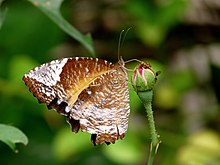Elymnias caudata
| Tailed palmfly | |
|---|---|

| |
| Male | |

| |
| Female | |
| Scientific classification | |
| Kingdom: | |
| Phylum: | |
| Class: | |
| Order: | |
| Family: | |
| Genus: | |
| Species: | E. caudata
|
| Binomial name | |
| Elymnias caudata Butler, 1871
| |
| Synonyms | |
| |
Elymnias caudata,[1][2] the tailed palmfly,[2] is a species of satyrine butterfly found in South India.[1][3] Some authors consider this as a subspecies of Elymnias hypermnestra.[3]
Description



This butterfly species are sexually dimorphic: males and females do not look alike. Males have black upperside forewings with small blue patches and mimic Euploea species, while the females mimic butterfly species of the genus Danaus.
Both sexes have the wings longer, proportionately to their breadth, and the tail at apex of vein 4 on the hindwing longer compared to Elymnias hypermnestra.
Upperside: Male differs from E. hypermnestra as follows:
the subterminal and preapical spots on the forewing white suffused slightly with dark scales; the terminal half of the hindwing tawny, more or less suffused with dusky black, which in some specimens forms a distinct border along the termen. Female similar to the female of E. hypermnestra, but the black more extended; veins 2, 3, and 4 on the hindwing broadly bordered with black.
Underside: Female differs from E. hypermnestra in the more conspicuous broadly triangular white pre-apical patch on the forewing, and in the prominence of the broad tawny terminal half of the upperside of the hindwing, which shows through a pale, sometimes pinkish brown on the underside. Antennae, head, thorax and abdomen brown, paler beneath and much paler in the female than in the male.[4][5]
Range
It is endemic to South India.[1][2]
Life history
Food plants
Cocos nucifera (coconut) Calamus pseudo-tenuis, Calamus rotang, Calamus thwaitesii, Phoenix loureiroi and Licuala species.[6]
Larva
"Spindle-shaped, slender, transversely rugose and clothed with short stout bristles...; head large, surmounted by two stout horns, sloping backwards, slightly branched at the ends; a pair of long straight caudal spines setose like the body; colour bright green with longitudinal yellow lines more or less distinct and two rows of large yellow spots tinged with green and sometimes tipped with black on the back; head dark brown, with a yellow cheek-stripe and frontal-line."[4]
Pupa
"Suspended by the tail only, but in a rigidly horizontal position, regular with the exception of two small pointed processes from the head and an acute thoracic projection above them; colour bright green, beautifully ornamented with four irregular rows of large yellow spots bordered with red." (Davidson & Aitken quoted by Bingham.)[4]
-
Larva
-
Pupa
-
Male (upperside)
-
Female (upperside)
See also
References
- ^ a b c "Elymnias caudata Butler, 1871" at Markku Savela's Lepidoptera and Some Other Life Forms
- ^ a b c "Elymnias caudata Butler, 1871 – Tailed Palmfly". Butterflies of India, v. 2.28. Indian Foundation for Butterflies. Retrieved 2017-05-19.
- ^ a b R.K., Varshney; Smetacek, Peter (2015). A Synoptic Catalogue of the Butterflies of India. New Delhi: Butterfly Research Centre, Bhimtal & Indinov Publishing, New Delhi. p. 161. doi:10.13140/RG.2.1.3966.2164. ISBN 978-81-929826-4-9.
- ^ a b c
 This article incorporates text from this source, which is in the public domain: Bingham, Charles Thomas (1905). Fauna of British India. Butterflies Vol. 1. pp. 173–174.
This article incorporates text from this source, which is in the public domain: Bingham, Charles Thomas (1905). Fauna of British India. Butterflies Vol. 1. pp. 173–174.
- ^
 This article incorporates text from this source, which is in the public domain: Moore, Frederic (1893–1896). Lepidoptera Indica. Vol. II. London: Lovell Reeve and Co. pp. 150–151.
This article incorporates text from this source, which is in the public domain: Moore, Frederic (1893–1896). Lepidoptera Indica. Vol. II. London: Lovell Reeve and Co. pp. 150–151.{{cite book}}: CS1 maint: date format (link) - ^ Kunte, K. (2006). Additions to known larval host plants of Indian butterflies. Journal of the Bombay Natural History Society 103(1):119–120
External links
 Data related to Elymnias caudata at Wikispecies
Data related to Elymnias caudata at Wikispecies Media related to Elymnias caudata at Wikimedia Commons
Media related to Elymnias caudata at Wikimedia Commons




